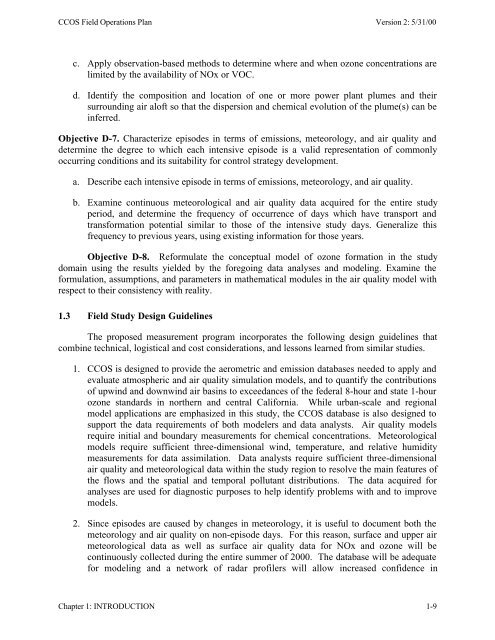Central California Ozone Study (CCOS) - Desert Research Institute
Central California Ozone Study (CCOS) - Desert Research Institute
Central California Ozone Study (CCOS) - Desert Research Institute
Create successful ePaper yourself
Turn your PDF publications into a flip-book with our unique Google optimized e-Paper software.
<strong>CCOS</strong> Field Operations Plan Version 2: 5/31/00<br />
c. Apply observation-based methods to determine where and when ozone concentrations are<br />
limited by the availability of NOx or VOC.<br />
d. Identify the composition and location of one or more power plant plumes and their<br />
surrounding air aloft so that the dispersion and chemical evolution of the plume(s) can be<br />
inferred.<br />
Objective D-7. Characterize episodes in terms of emissions, meteorology, and air quality and<br />
determine the degree to which each intensive episode is a valid representation of commonly<br />
occurring conditions and its suitability for control strategy development.<br />
a. Describe each intensive episode in terms of emissions, meteorology, and air quality.<br />
b. Examine continuous meteorological and air quality data acquired for the entire study<br />
period, and determine the frequency of occurrence of days which have transport and<br />
transformation potential similar to those of the intensive study days. Generalize this<br />
frequency to previous years, using existing information for those years.<br />
Objective D-8. Reformulate the conceptual model of ozone formation in the study<br />
domain using the results yielded by the foregoing data analyses and modeling. Examine the<br />
formulation, assumptions, and parameters in mathematical modules in the air quality model with<br />
respect to their consistency with reality.<br />
1.3 Field <strong>Study</strong> Design Guidelines<br />
The proposed measurement program incorporates the following design guidelines that<br />
combine technical, logistical and cost considerations, and lessons learned from similar studies.<br />
1. <strong>CCOS</strong> is designed to provide the aerometric and emission databases needed to apply and<br />
evaluate atmospheric and air quality simulation models, and to quantify the contributions<br />
of upwind and downwind air basins to exceedances of the federal 8-hour and state 1-hour<br />
ozone standards in northern and central <strong>California</strong>. While urban-scale and regional<br />
model applications are emphasized in this study, the <strong>CCOS</strong> database is also designed to<br />
support the data requirements of both modelers and data analysts. Air quality models<br />
require initial and boundary measurements for chemical concentrations. Meteorological<br />
models require sufficient three-dimensional wind, temperature, and relative humidity<br />
measurements for data assimilation. Data analysts require sufficient three-dimensional<br />
air quality and meteorological data within the study region to resolve the main features of<br />
the flows and the spatial and temporal pollutant distributions. The data acquired for<br />
analyses are used for diagnostic purposes to help identify problems with and to improve<br />
models.<br />
2. Since episodes are caused by changes in meteorology, it is useful to document both the<br />
meteorology and air quality on non-episode days. For this reason, surface and upper air<br />
meteorological data as well as surface air quality data for NOx and ozone will be<br />
continuously collected during the entire summer of 2000. The database will be adequate<br />
for modeling and a network of radar profilers will allow increased confidence in<br />
Chapter 1: INTRODUCTION 1-9
















